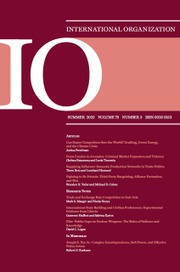No CrossRef data available.
Article contents
Conflicts that Leave Something to Chance
Published online by Cambridge University Press: 01 July 2025
Abstract
The development of nuclear weapons added a new dimension to conventional conflict: the possibility that it could inadvertently escalate into a nuclear exchange. How does this relationship between conventional war and nuclear escalation shape deterrence? I present a formal model of deterrence and arming. The novelty here is that investing in conventional capabilities has a direct effect on the balance of power but also an indirect effect on conflict duration and the likelihood of an accidental nuclear exchange. I find that accounting for the risk of nuclear escalation may require greater conventional force postures for deterrence, thus lowering welfare in the absence of nuclear war. I also find the nuclear era will be more peaceful, but when conflicts occur, they may be more aggressive and decisive. These results (and others) offer insight into the difficulty of substituting nuclear weapons for conventional arms, and into the Soviet response to the 1956 Hungarian Revolution.
Keywords
Information
- Type
- Research Article
- Information
- Copyright
- © The Author(s), 2025. Published by Cambridge University Press on behalf of The IO Foundation

